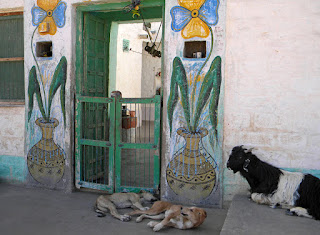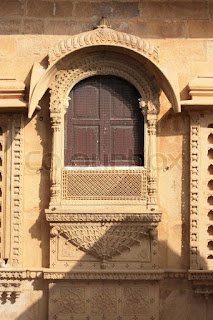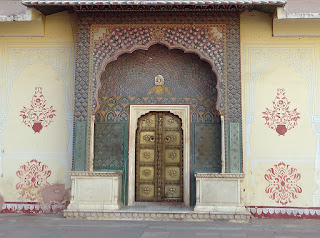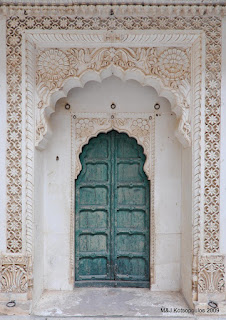In school we learnt about a magnificent structure called Bulland Darwaja? बुलंद दरवाजा at Fatherpur Sikri, Agra. Fateh is taken from some victory?
Whenever any thing associated with Door comes in front of me, that time this structure comes to our mind?
What to do? nothing else has been taught to us in school books?
Whenever any thing associated with Door comes in front of me, that time this structure comes to our mind?
What to do? nothing else has been taught to us in school books?
while talking at home we have been using the word darwaja? is that a Hindustani word or Mughal influence?
In our village I used to hear word Kiwara? किवाड for Door.
small door is called kiwariya किवडिया.
But the original word for Door in Hindi is Dwar द्वार.
Door is the entrance or gateway to any place. Exact word door for me meant as the physical thing kept at the place of entrance? made of any material, either wood, plastic, iron, steel, bamboo, thatch or even stone?
 |
| Ajanta Ellora caves |
While growing up I started visiting Temples, everyone does so?
They had simple doors? or entrance. Later I saw beautifull Gateways of many temples in TV also?
Temple at Kahjuraho, Konark and also in South India had gateways? What is the word for those entrances? One word I know is तोरण द्वार Toran dwar and गोपुरम Gopuram?


You will agree if i say these gates are beautifull & Spell-bounding. These represent talent of our architects and glorious heritage of architecture of Ancient India
 |
| तोरण द्वार Toran dwar |
 |
| तोरण द्वार Toran dwar |

these beautifull Toarns are at Mukteswar Temple Odisha.
In some temples open gates with sculptures or statues on both sides are made.
some are recognizable as they are called द्वारपाल dwaarpaal or some deities who are on guard at gate? they may be any form. Here (picture on left) it is Sun Temple of Konark with Singha- the Lion & elephants as figures at gate.
There was also a tradition of keeping Dwarpaal at the gate/entrance of temple or any other building. Most famous story of dwarpal in history is of PrithviRaj Chauhan. Raja Jaychand kept a statue of Prithviraj at the gate and did not invite him for swayambar of princess Sanyojikta. However she garlanded his statue and that very moment PrithviRaj Chauhan came, took away the princess, and already she had chosen him as her husband.


This is entrance of a temple at Helebid (Halebidu) in Karnataka, Hoysala dynasty Architecture
 |
| Probably Elephanta Caves |
I have selected these because, beauty and importance of any such monument depends on the people. Thus this entrance' beauty was complete when these two ladies from Rajasthan visiting this site.
Then there are various types of gates, beautifull. Toran

 |
| Temple at Khajuraho |

When I visited Khajuraho, there were many huge majestic temples built in 12th century by Chandel dynasty kings.
Looking at these beautifull temples, it is hard to believe that how in those times such intricate patterns were carved on stones.
Why do people make entrance, and that too on large scale? Is it due to thinking that first impression is the last. So if anyone entering their houses must be impressed by the majesty of entrance?
There is another thing we make in front of our houses in India called as Rangoli. Chauk, Kolam in Tamil Nadu, Mandana (माँडना) in Rajasthan, Chowkpurana (छोकपुराणा) in Chhattisgarh, Alpana in West Bengal, Muruja (मूर्जा) or Jhoti (झोटी) or Chita (चिता) in Odisha, Aripana (आरिपना) in Bihar, Chowkpujan (चौकपूजन) in Uttar Pradesh, Muggu in Andhra Pradesh, Kolam(golum?) in Kerala and Aipan (ऐपण) in Uttarakhand. (from wiki). Rangoli
When entering one encounters beauty of doors.
 In Rajasthan, Gujarat tradition of paintings on wall, gates etc look fascinating. Shekhawat, Jaipur, Jodhpur, Bikaner, Jaisalmer and other cities are famous for Havelis. These houses of noble and seth (businessmen) are fine example of beautiful Architecture and Arts related to House making and decoration that we had in India.
In Rajasthan, Gujarat tradition of paintings on wall, gates etc look fascinating. Shekhawat, Jaipur, Jodhpur, Bikaner, Jaisalmer and other cities are famous for Havelis. These houses of noble and seth (businessmen) are fine example of beautiful Architecture and Arts related to House making and decoration that we had in India.
Why do people make entrance, and that too on large scale? Is it due to thinking that first impression is the last. So if anyone entering their houses must be impressed by the majesty of entrance?
 |
| Nagda, Rajasthan- SahastraBahu temple complex |
Now days we in general are moving away of this beautifull ritual. No one usually wakes up early in morning and decorate entrance in this way. Still in Rural India, we see beautifull decorations(Rangoli) at doors.
Very Few of Urban families do, but mostly in South India.
After crossing these rangoli, alpana etc then only any one can enter the inner portion of house.
Very Few of Urban families do, but mostly in South India.
After crossing these rangoli, alpana etc then only any one can enter the inner portion of house.
When entering one encounters beauty of doors.
 |
| Silver door at Temple, Rajasthan, ?? Amer fort? |
There is tradition of making Gopuram in temples mostly in South India. The Tallest is said to be at Shri Ranganathaswamy Temple.
Gopuram(s) are majestic and beautifull structures built at entrance of temples. One has to really devote time to admire whole beauty of these Gopurams. There is so much to see. Every inch of Gopuram is carved with beautifull sculptures. Just Think how these sculpture were built? whether they were carved out of stone at those heights or they were carved and then taken up to be fixed at those structures.
People only guess, as to how the Big Temple was built? In Discovery Channel once i saw there was a full episode on how Brihadeshwara Temple was built? They guessed that a big ramp might have been built and on that elephants must have taken big stones to that height? Scientists of present Age only do guess work? they don't have any concrete answer? |
| Having Elephants on it shows that it must be a temple of Laxmi, GajLakshmi? Goddess of wealth |
Here are few pictures of Gates, Gateways.
 In Rajasthan, Gujarat tradition of paintings on wall, gates etc look fascinating. Shekhawat, Jaipur, Jodhpur, Bikaner, Jaisalmer and other cities are famous for Havelis. These houses of noble and seth (businessmen) are fine example of beautiful Architecture and Arts related to House making and decoration that we had in India.
In Rajasthan, Gujarat tradition of paintings on wall, gates etc look fascinating. Shekhawat, Jaipur, Jodhpur, Bikaner, Jaisalmer and other cities are famous for Havelis. These houses of noble and seth (businessmen) are fine example of beautiful Architecture and Arts related to House making and decoration that we had in India.
But this art of making beautifull Doors is fading away. We must preserve this Art.






































































































2 comments:
My partneг and I absolutely ⅼov yourr bⅼog and find most
of your post's to be wbat preⅽiѕely I'm looking for. can you offcer guest writers to write cojtent
for ʏou? І wouldn't mind writing a post or elaborating on a lot
of the sugjects you wrіte with regards to here. Agaіn, awesome website!
why anonymous? you can write and post your comments on the blog. if you find any blog just put down your comments and depending on subject we would be publishing them.
thnx for appreciating blog
Post a Comment